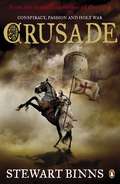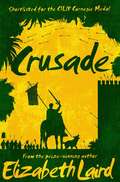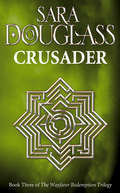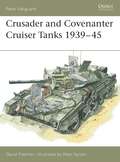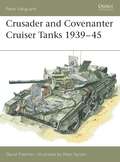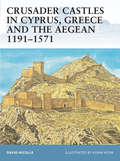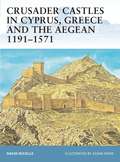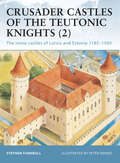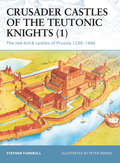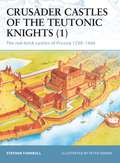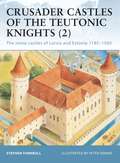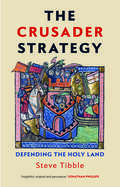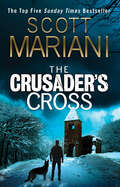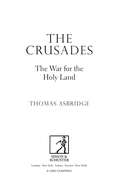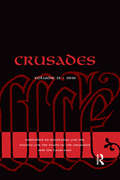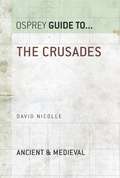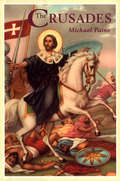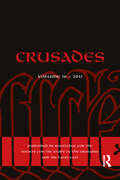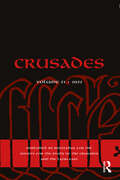- Table View
- List View
Crusade (The Making of England Quartet #2)
by Stewart Binns1072 - England is firmly under the heel of its new Norman rulers. The few survivors of the English resistance look to Edgar the Atheling, the rightful heir to the English throne, to overthrow William the Conqueror. Years of intrigue and vicious civil war follow: brother against brother, family against family, friend against friend.In the face of chaos and death, Edgar and his allies form a secret brotherhood, pledging to fight for justice and freedom wherever they are denied. But soon they are called to fight for an even greater cause: the plight of the Holy Land. Embarking on the epic First Crusade to recapture Jerusalem, together they will participate in some of the cruellest battles the world has ever known, the savage Siege of Antioch and the brutal Fall of Jerusalem, and together they will fight to the death.
Crusade
by Elizabeth LairdCrusade is a richly detailed historical adventure, from Carnegie shortlisted author, Elizabeth Laird.Two boys. Two faiths. One unholy war . . .When Adam's mother dies unconfessed, he pledges to save her soul with dust from the Holy Land. Employed as a dog-boy for the local knight, Adam grabs the chance to join the Crusade to reclaim Jerusalem. He burns with determination to strike down the infidel enemy . . .Salim, a merchant's son, is leading an uneventful life in the port of Acre - until news arrives that a Crusader attack is imminent. To keep Salim safe, his father buys him an apprenticeship with an esteemed, travelling doctor. But Salim's employment leads him to the heart of Sultan Saladin's camp - and into battle against the barbaric and unholy invaders . . .
Crusader: Wayfarer Redemption, Enchanter, Starman, Sinner, Pilgrim, Crusader (Wayfarer Redemption Ser. #6)
by Sara DouglassThe last book of the Wayfarerer Redemption, an enthralling continuation of The Axis trilogy, by the bestselling Australian author Sara Douglass
Crusader and Covenanter Cruiser Tanks 1939–45 (New Vanguard)
by Peter Sarson David FletcherThe Covenanter (which never saw active service) and Crusader Cruiser tanks were developed between 1939 and 1940. The Crusader first saw action in the North African desert in June 1941: its speed and sleek design made it a hard target to hit, and the tank was well-respected by the Afrikakorps for its velocity in combat. But its hurried development prior to World War II also made it prone to mechanical failure. This book examines the Covenanter and the many variants of the Crusader tank, detailing the designs, developments and disappointments of these infamous World War II tanks.
Crusader and Covenanter Cruiser Tanks 1939–45 (New Vanguard #Vol. 14)
by Peter Sarson David FletcherThe Covenanter (which never saw active service) and Crusader Cruiser tanks were developed between 1939 and 1940. The Crusader first saw action in the North African desert in June 1941: its speed and sleek design made it a hard target to hit, and the tank was well-respected by the Afrikakorps for its velocity in combat. But its hurried development prior to World War II also made it prone to mechanical failure. This book examines the Covenanter and the many variants of the Crusader tank, detailing the designs, developments and disappointments of these infamous World War II tanks.
Crusader Castles in Cyprus, Greece and the Aegean 1191–1571 (Fortress #59)
by Mr Adam Hook Dr David NicolleThe castles built by the Crusaders, Hospitallers, Venetians and Genoese in Cyprus, Greece, the Aegean, and on the Black Sea served to defend against a complex array of constantly changing threats: Mamluks, Catalan mercenaries, Ottoman Turks, Byzantines, independent Islamic states, Timur-i-Lenk, and widespread piracy, to name but few. The resulting fortifications some inherited from conquered the territories of the former Byzantine empire, some built from scratch were very different to those found in the Middle East. This superbly illustrated book explores their design, development and fate in detail, documenting the rich architectural heritage of this region and its complex history.
Crusader Castles in Cyprus, Greece and the Aegean 1191–1571 (Fortress)
by David Nicolle Adam HookThe castles built by the Crusaders, Hospitallers, Venetians and Genoese in Cyprus, Greece, the Aegean, and on the Black Sea served to defend against a complex array of constantly changing threats: Mamluks, Catalan mercenaries, Ottoman Turks, Byzantines, independent Islamic states, Timur-i-Lenk, and widespread piracy, to name but few. The resulting fortifications some inherited from conquered the territories of the former Byzantine empire, some built from scratch were very different to those found in the Middle East. This superbly illustrated book explores their design, development and fate in detail, documenting the rich architectural heritage of this region and its complex history.
Crusader Castles of the Teutonic Knights: The stone castles of Latvia and Estonia 1185–1560 (Fortress #19)
by Peter Dennis Dr Stephen TurnbullALSO AVAILABLE TO BUY AS AN E-BOOK. The original forced conversion of pagan Livonia, what is now the Baltic states of Latvia and Estonia, was carried out by a military order known as the Brethren of the Sword. In 1236 this order was incorporated into the Teutonic Knights following a catastrophic military defeat. The knights had always consolidated their conquests through networks of castles and fortified places, and the Livonian Chapter of the Teutonic Order built castles of stone. This title covers the developmental and operational history of these fortresses over the length of the Middle Ages. It details how the Baltic fortifications of the Teutonic Knights evolved to reflect the changing nature of siege warfare and the increasing dominance of gunpowder in warfare.
Crusader Castles of the Teutonic Knights: The red-brick castles of Prussia 1230–1466 (Fortress #11)
by Peter Dennis Dr Stephen TurnbullALSO AVAILABLE TO BUY AS AN E-BOOK. Throughout their stormy history the Teutonic Knights of Germany have always been the most controversial brotherhood ever to call themselves 'Knights of Christ'.They were the most warlike of the religious orders, and this is reflected in the architecture they left behind. In contrast to the Templars who are remembered for their churches, the Teutonic memorials are the magnificent brick-built castles they built as a result of their conquest of Prussia between 1230 and 1380. Many of these dramatic fortresses still exist today in what is now Poland and provide a unique example of an architectural style that closely reflects the nature of the Order.
Crusader Castles of the Teutonic Knights: The red-brick castles of Prussia 1230–1466 (Fortress)
by Peter Dennis Stephen TurnbullThroughout their stormy history the Teutonic Knights of Germany have always been the most controversial brotherhood ever to call themselves 'Knights of Christ'.They were the most warlike of the religious orders, and this is reflected in the architecture they left behind. In contrast to the Templars who are remembered for their churches, the Teutonic memorials are the magnificent brick-built castles they built as a result of their conquest of Prussia between 1230 and 1380. Many of these dramatic fortresses still exist today in what is now Poland and provide a unique example of an architectural style that closely reflects the nature of the Order.
Crusader Castles of the Teutonic Knights: The stone castles of Latvia and Estonia 1185–1560 (Fortress #19)
by Peter Dennis Stephen TurnbullThe original forced conversion of pagan Livonia, what is now the Baltic states of Latvia and Estonia, was carried out by a military order known as the Brethren of the Sword. In 1236 this order was incorporated into the Teutonic Knights following a catastrophic military defeat. The knights had always consolidated their conquests through networks of castles and fortified places, and the Livonian Chapter of the Teutonic Order built castles of stone. This title covers the developmental and operational history of these fortresses over the length of the Middle Ages. It details how the Baltic fortifications of the Teutonic Knights evolved to reflect the changing nature of siege warfare and the increasing dominance of gunpowder in warfare.
Crusader Criminals: The Knights Who Went Rogue in the Holy Land
by Steve TibbleA vivid new history of the criminal underworld in the medieval Holy Land The religious wars of the crusades are renowned for their military engagements. But the period was witness to brutality beyond the battlefield. More so than any other medieval war zone, the Holy Land was rife with unprecedented levels of criminality and violence. In the first history of its kind, Steve Tibble explores the criminal underbelly of the crusades. From gangsters and bandits to muggers and pirates, Tibble presents extraordinary evidence of an illicit underworld. He shows how the real problem in the region stemmed not from religion but from young men. Dislocated, disinhibited, and present in disturbingly large numbers, they were the propellant that stoked two centuries of unceasing warfare and shocking levels of criminality. Crusader Criminals charts the downward spiral of desensitisation that grew out of the horrors of incessant warfare—and in doing so uncovers some of the most surprising stories of the time.
The Crusader Strategy: Defending the Holy Land
by Steve TibbleA new look at the crusaders, which shows how they pursued long-term plans and clear strategic goals Medieval states, and particularly crusader societies, often have been considered brutish and culturally isolated. It seems unlikely that they could develop “strategy” in any meaningful sense. However, the crusaders were actually highly organized in their thinking and their decision making was rarely random. In this lively account, Steve Tibble draws on a rich array of primary sources to reassess events on the ground and patterns of behavior over time. He shows how, from aggressive castle building to implementing a series of invasions of Egypt, crusader leaders tenaciously pursued long-term plans and devoted single-minded attention to clear strategic goals. Crusader states were permanently on the brink of destruction; resources were scarce and the penalties for failure severe. Intuitive strategic thinking, Tibble argues, was a necessity, not a luxury.
Crusader vs M13/40: North Africa 1941–42 (Duel #137)
by David GreentreeThis illustrated study assesses the British Crusader and the Italian M13/40, two medium tanks that played crucial roles in World War II's Desert War. Making its combat debut in North Africa during December 1940, Italy's M13/40 medium tank was armed with a 47mm main gun. Its British opposite number, the Crusader I, was armed with a 2-pdr (40mm) main gun; it entered the fighting in June 1941. While the M13/40 could fire armour-piercing rounds but also high-explosive ammunition against infantry and towed-gun targets, the Crusader could only fire armour-piercing ammunition. In this book, David Greentree charts the evolution of these two tanks as the Desert War raged on.While the Crusader III, making its debut at the Second Battle of El Alamein in October 1942, was armed with the much more effective 6-pdr (57mm), the M13/40 could not be upgunned or uparmoured; new types such as the US-built M3 Grant tipped the balance in favour of the British. Joined in the front line by the similar M14/41, the M13/40 soldiered on; as the M4 Sherman also entered British service, the Italian tanks were largely wiped out as the Axis forces retreated from Egypt.Featuring all-new full-colour artwork, archive photographs and expert analysis, this engaging study assess the origins, development and combat effectiveness of these two mainstays of the Desert War during 1941–42.
Crusader vs M13/40: North Africa 1941–42 (Duel #137)
by David GreentreeThis illustrated study assesses the British Crusader and the Italian M13/40, two medium tanks that played crucial roles in World War II's Desert War. Making its combat debut in North Africa during December 1940, Italy's M13/40 medium tank was armed with a 47mm main gun. Its British opposite number, the Crusader I, was armed with a 2-pdr (40mm) main gun; it entered the fighting in June 1941. While the M13/40 could fire armour-piercing rounds but also high-explosive ammunition against infantry and towed-gun targets, the Crusader could only fire armour-piercing ammunition. In this book, David Greentree charts the evolution of these two tanks as the Desert War raged on.While the Crusader III, making its debut at the Second Battle of El Alamein in October 1942, was armed with the much more effective 6-pdr (57mm), the M13/40 could not be upgunned or uparmoured; new types such as the US-built M3 Grant tipped the balance in favour of the British. Joined in the front line by the similar M14/41, the M13/40 soldiered on; as the M4 Sherman also entered British service, the Italian tanks were largely wiped out as the Axis forces retreated from Egypt.Featuring all-new full-colour artwork, archive photographs and expert analysis, this engaging study assess the origins, development and combat effectiveness of these two mainstays of the Desert War during 1941–42.
The Crusader’s Cross (Ben Hope #24)
by Scott MarianiThe gripping new Ben Hope thriller from the Sunday Times bestseller. THEY THOUGHT HE WAS AN EASY TARGET. THEY THOUGHT WRONG.
The Crusades: The War for the Holy Land
by Thomas AsbridgeReleased to coincide with a major BBC TV documentary series on the crusades presented by the author. In the eleventh century, a vast Christian army, summoned to holy war by the pope, rampaged through the Muslim world of the eastern Mediterranean, seizing possession of Jerusalem, a city revered by both faiths. Over the two hundred years that followed this First Crusade, Islam and the West fought for dominion of the Holy Land, clashing in a succession of chillingly brutal wars, both firm in the belief that they were at God's work. For the first time, this book tells the story of this epic struggle from the perspective of both Christians and Muslims, reconstructing the experiences and attitudes of those on either side of the conflict. Mixing pulsing narrative and piercing insight, it exposes the full horror, passion and barbaric grandeur of the crusading era. One of the world's foremost authorities on the subject, Thomas Asbridge offers a vivid and penetrating history of the crusades, setting a new standard for modern scholarship. Drawing upon painstaking original research and an intimate knowledge of the Near East, he uncovers what drove Muslims and Christians alike to embrace the ideals of jihadand crusade, revealing how these holy wars reshaped the medieval world and why they continue to echo in human memory to this day.
Crusades: Volume 15 (Crusades)
by Benjamin Z. Kedar Jonathan Phillips Jonathan Riley-Smith Nikolaos G. ChrissisCrusades covers seven hundred years from the First Crusade (1095-1102) to the fall of Malta (1798) and draws together scholars working on theatres of war, their home fronts and settlements from the Baltic to Africa and from Spain to the Near East and on theology, law, literature, art, numismatics and economic, social, political and military history. Routledge publishes this journal for The Society for the Study of the Crusades and the Latin East. Particular attention is given to the publication of historical sources in all relevant languages - narrative, homiletic and documentary - in trustworthy editions, but studies and interpretative essays are welcomed too. Crusades also incorporates the Society's Bulletin.
Crusades: Volume 15 (Crusades)
by Benjamin Z. Kedar Jonathan Phillips Jonathan Riley-Smith Nikolaos G. ChrissisCrusades covers seven hundred years from the First Crusade (1095-1102) to the fall of Malta (1798) and draws together scholars working on theatres of war, their home fronts and settlements from the Baltic to Africa and from Spain to the Near East and on theology, law, literature, art, numismatics and economic, social, political and military history. Routledge publishes this journal for The Society for the Study of the Crusades and the Latin East. Particular attention is given to the publication of historical sources in all relevant languages - narrative, homiletic and documentary - in trustworthy editions, but studies and interpretative essays are welcomed too. Crusades also incorporates the Society's Bulletin.
The Crusades (Guide to...)
by Dr David NicolleBorn amid immense suffering and bloodshed, the Kingdom of Jerusalem remained a battlefield for almost 200 years. The Crusades gave rise to the Military Orders of the Templars and Hospitallers, and were a backdrop to the careers of some of history's most famous leaders including Richard 'The Lionheart' and Saladin. On occasion the savagery of the Crusaders left their opponents reeling, creating frictions that survived for more than 700 years. At the same time, as this book lavishly illustrates, art, architecture and learning all benefited from new knowledge the Crusaders brought back from the East.
The Crusades
by Mike PaineThe first crusade was set in motion by Pope Urban II in 1095 and culminated in the capture of Jerusalem from the Muslims four years later. In 1291 the fall of Acre marked the loss of the last Christian enclave in the Holy Land.This Pocket Essential traces the chronology of the Crusades between these two dates and highlights the most important figures on all sides of the conflict. It covers the creation of the kingdom of Jerusalem and the other crusader states and their struggle to survive. It looks at the successes and failures of the Third Crusade and at the legendary figures of Richard the Lionheart and Saladin, explores the truth and the myths behind the orders of military monks like the Hospitallers and examines such strange historical events as the Children's Crusade and the crusader sacking of Byzantium in 1204. It also looks at the struggles of the Teutonic Knights against paganism in the Baltic.The book provides the essential information about one of the great unifying, and disunifying, forces of medieval Christendom.
Crusades: Volume 16 (Crusades)
by Jonathan Phillips Nikolaos G. Chrissis Edited by Benjamin Z. KedarCrusades covers seven hundred years from the First Crusade (1095-1102) to the fall of Malta (1798) and draws together scholars working on theatres of war, their home fronts and settlements from the Baltic to Africa and from Spain to the Near East and on theology, law, literature, art, numismatics and economic, social, political and military history. Routledge publishes this journal for The Society for the Study of the Crusades and the Latin East. Particular attention is given to the publication of historical sources in all relevant languages - narrative, homiletic and documentary - in trustworthy editions, but studies and interpretative essays are welcomed too. Crusades also incorporates the Society's Bulletin.
Crusades: Volume 16 (Crusades)
by Jonathan Phillips Benjamin Z. Kedar Nikolaos G. ChrissisCrusades covers seven hundred years from the First Crusade (1095-1102) to the fall of Malta (1798) and draws together scholars working on theatres of war, their home fronts and settlements from the Baltic to Africa and from Spain to the Near East and on theology, law, literature, art, numismatics and economic, social, political and military history. Routledge publishes this journal for The Society for the Study of the Crusades and the Latin East. Particular attention is given to the publication of historical sources in all relevant languages - narrative, homiletic and documentary - in trustworthy editions, but studies and interpretative essays are welcomed too. Crusades also incorporates the Society's Bulletin.
Crusades: Volume 21 (Crusades)
by Jonathan Phillips Iris Shagrir Benjamin Z. KedarCrusades covers the seven hundred years from the First Crusade (1095-1102) to the fall of Malta (1798) and draws together scholars working on theatres of war, their home fronts and settlements from the Baltic to Africa and from Spain to the Near East and on theology, law, literature, art, numismatics and economic, social, political and military history. Routledge publishes this journal for The Society for the Study of the Crusades and the Latin East. Particular attention is given to the publication of historical sources - narrative, homiletic and documentary - but studies and interpretative essays are welcomed too. Crusades also incorporates the Society's Bulletin. The editors are Professor Jonathan Phillips, Royal Holloway, University of London, UK; Iris Shagrir, The Open University of Israel; Professor Benjamin Z. Kedar, Hebrew University of Jerusalem, Israel; and Nikolaos G. Chrissis, Democritus University of Thrace, Greece.
Crusades: Volume 21 (Crusades)
by Jonathan Phillips Iris Shagrir Benjamin Z. Kedar Nikolaos G. ChrissisCrusades covers the seven hundred years from the First Crusade (1095-1102) to the fall of Malta (1798) and draws together scholars working on theatres of war, their home fronts and settlements from the Baltic to Africa and from Spain to the Near East and on theology, law, literature, art, numismatics and economic, social, political and military history. Routledge publishes this journal for The Society for the Study of the Crusades and the Latin East. Particular attention is given to the publication of historical sources - narrative, homiletic and documentary - but studies and interpretative essays are welcomed too. Crusades also incorporates the Society's Bulletin. The editors are Professor Jonathan Phillips, Royal Holloway, University of London, UK; Iris Shagrir, The Open University of Israel; Professor Benjamin Z. Kedar, Hebrew University of Jerusalem, Israel; and Nikolaos G. Chrissis, Democritus University of Thrace, Greece.
